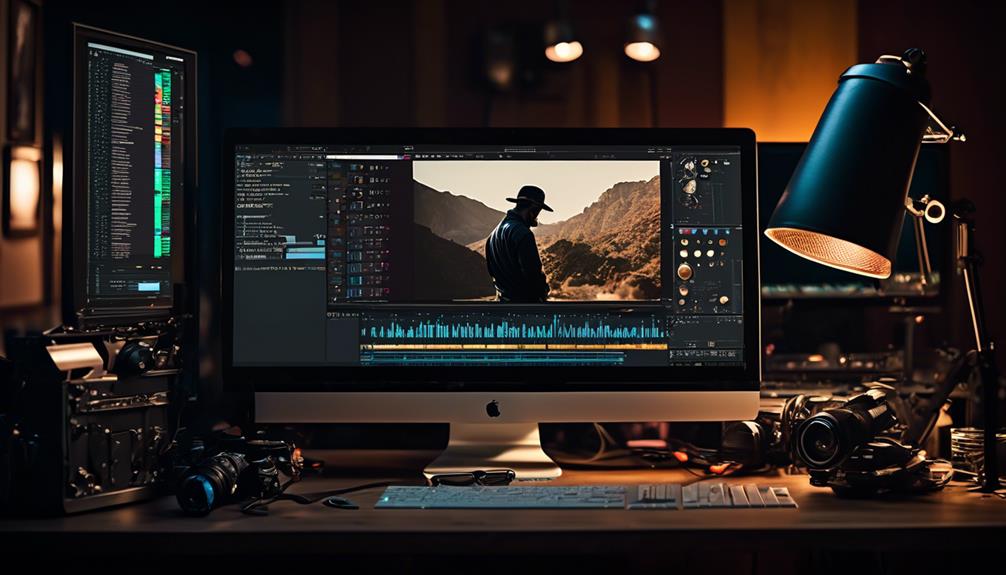Please note this post may contain affiliate links picked by me (Jay) that I have deemed may be of interest or relevant to you the reader of this.
These links do not affect the cost of the thing if you decide to purchase but i may get a little money if you choose to purchase.
For more information on my affiliate link policy click here.
Just as I was finalizing an image from my latest wedding shoot, it struck me how crucial post-production has become in distinguishing a successful photography business.
In this industry, it’s not just about snapping the perfect moment—it’s equally about the magic that happens afterward, in the digital darkroom. I’ve honed my post-production process to ensure each image not only reflects my artistic vision but also satisfies my clients’ desires.
An efficient workflow, paired with advanced color correction skills and the smart use of presets and actions, can significantly reduce editing time and increase overall output quality. Effective batch processing and stringent quality control measures are my secret weapons for maintaining a consistent, high-caliber portfolio.
But, what truly elevates a photography business is knowing how to blend these techniques seamlessly into your unique brand. Stick around, and I’ll share insights on how to leverage these strategies to create a post-production workflow that sets your business apart in an oversaturated market.
Streamlining Your Workflow

Streamlining your workflow is key to turning around projects swiftly while maintaining high quality in your photography business. I’ve learned that it’s not just about cutting corners; it’s about smart management and leveraging the right tools to ensure that you’re efficient without compromising the artistry or integrity of your work.
Equipment maintenance is crucial in this equation. There’s nothing that disrupts a smooth workflow like equipment failure. I keep a rigorous schedule for servicing my gear, and I’m always on the lookout for software updates and new techniques that can shave precious minutes off my editing time. Ensuring everything is in top shape means I’m ready to go when inspiration strikes or deadlines loom.
But let’s not forget client communication. It’s the linchpin of any photography project. I’ve streamlined this aspect by implementing a system where clients can easily provide their feedback and preferences, which integrates seamlessly into my workflow. This cuts down on back-and-forth and misunderstandings, which can otherwise derail a project. By innovating the way I interact with clients, I’m not just meeting their expectations—I’m exceeding them, all while keeping my process slick and my output stellar.
Advanced Color Correction Techniques
Building on the foundation of an efficient workflow, mastering advanced color correction techniques is essential for bringing out the best in each photograph and setting your work apart in a competitive market. I’ve found that color grading isn’t just about balance; it’s about emotion and storytelling. Modern tools allow me to manipulate colors to set a mood that aligns with the narrative of the image.
Let’s talk Histogram analysis. This is my go-to for understanding the tonal range of an image. It’s not just about the peaks and valleys; it’s reading between the lines to ensure there’s detail in the shadows without losing the highlights.
| Technique | Purpose | Tool Example |
|---|---|---|
| Curves Adjustment | Fine-tune luminance and color | Photoshop Curves |
| Color Channels | Isolate and adjust specific colors | Lightroom HSL |
| Split Toning | Add color tints to highlights/shadows | Capture One |
Incorporating these techniques into my post-production strategy has not only improved the quality of my final images but also has added depth to my artistic expression. It’s like giving each photo a voice, ensuring it’s heard loud and clear in the visual marketplace.
Effective Batch Processing

While individual tweaks can elevate a single photo, employing batch processing is crucial when dealing with multiple images to maintain consistency and save time. As a professional in the field, I’ve learned that time management is integral to a successful photography business. Batch processing isn’t just a neat trick; it’s a fundamental strategy that allows me to edit multiple photos swiftly while ensuring they all match the desired aesthetic.
Here are three tactics that have transformed my batch processing workflow:
- Pre-define Editing Presets: Before diving into editing, I create presets tailored to the specific requirements of a shoot. This ensures uniformity across images and slashes the time spent on adjustments.
- Software Choices Matter: Not all editing software is created equal. I invest in software that offers robust batch processing capabilities, making it easier to apply edits across a multitude of images without sacrificing control or quality.
- Selective Synchronization: I’ve mastered the art of syncing only the necessary adjustments across images. This nuanced approach prevents the one-size-fits-all pitfall and honors each photo’s unique elements.
Adopting these strategies hasn’t only refined my post-production workflow but also allowed me more time to focus on the creative and business growth aspects of my craft.
Utilizing Presets and Actions
Harnessing the power of presets and actions can revolutionize your workflow, turning hours of monotonous editing into just a few clicks. As someone deeply entrenched in the nuances of post-production, I’ve found that leveraging these tools not only accelerates the editing process but also opens the door to creative experimentation. It’s a game-changer for photographers who want to stay innovative and efficient.
Diving into preset customization, I tailor each preset to the specific needs of my images or a particular project. This approach ensures that my artistic vision isn’t lost in the pursuit of speed. I adjust parameters such as contrast, saturation, and sharpness, crafting a unique starting point for each session. It’s a bit like concocting a secret sauce that gives my images a consistent flavor while still allowing for individual seasoning.
Moreover, by creating actions that automate routine tasks, I free up time to focus on the creative aspects of my business. This isn’t just about cutting corners; it’s about smartly allocating resources to where they make the biggest impact. It’s about infusing efficiency with creativity, ensuring that every image I deliver maintains the high standard my clients expect and my portfolio demands.
Quality Control and Delivery

After fine-tuning the editing process with presets and actions, it’s critical to shift focus to the meticulous quality control and delivery that ensure each photo meets professional standards before reaching the client. The devil’s in the details, and I can’t afford to skip this step if I want to stand out in this competitive field.
Here’s a rundown of my quality control checklist:
- Pixel-Perfect Inspection: I zoom in and scrutinize each image pixel by pixel. It’s tedious, but necessary, to catch any overlooked blemishes or inconsistencies.
- Client Feedback Loop: Before the final delivery, I create a space for client feedback. This step is crucial for understanding their needs and guarantees that the end product resonates with their vision.
- Secure Transfer: Using encrypted services for the delivery of images not only protects my work but also reassures clients that their privacy is valued.
Balancing speed with precision, I’ve automated part of my quality checks without compromising the bespoke touch my clients love. It’s a game of constant innovation, and I’m always on the lookout for tools that can help me maintain that high standard while delivering a seamless, secure experience for my clients.
Frequently Asked Questions
How Can I Protect My Photography Business From Copyright Infringement During the Post-Production Phase?
To protect my work from copyright infringement, I’ve mastered watermarking techniques. They’re subtle yet effective, deterring theft while maintaining the aesthetic.
I also use digital rights management to control image distribution. It’s all about staying ahead with innovative solutions that safeguard my creative rights.
This approach ensures my photography remains exclusively mine, giving me peace of mind during the post-production phase and beyond. It’s essential in today’s digital landscape.
What Are Some Tips for Managing Client Expectations and Communications During the Editing Process?
To manage client expectations during editing, I set clear timelines and communicate them upfront. I’m always open to client feedback, ensuring it’s factored into the process.
By keeping a dialogue open and transparent about the editing timeline, I prevent misunderstandings and maintain trust.
It’s crucial to strike a balance between their vision and my expertise, fostering a collaborative environment that leads to innovative and satisfying results.
How Can I Effectively Track the Time Spent on Post-Production to Ensure I’m Pricing My Services Correctly?
Did you know that creatives often undercharge by 20% due to inaccurate time tracking?
To avoid this, I’ve started using time tracking tools, meticulously recording every editing minute. This precision enables me to refine my pricing strategies, ensuring I’m compensated fairly for my efforts.
It’s not just about billing; it’s about recognizing the value of my time and expertise, ultimately driving innovation in how I manage my photography business.
Are There Ethical Considerations I Should Be Aware of When Altering Images in Post-Production?
Absolutely, there are ethical considerations to keep in mind.
When I’m tweaking images, I always consider image authenticity and ethical boundaries. It’s crucial to strike a balance between enhancing a photo and misrepresenting the reality.
I’m committed to innovation but also to honesty in my work. Clients trust me to deliver real moments, not fabricated ones, so I ensure any alterations don’t compromise the genuine essence of the shot.
How Do I Handle Data Security and Privacy Concerns When Sharing Proofs and Final Images With Clients?
To ensure my clients’ data security and privacy, I’ve adopted robust cloud storage solutions with advanced encryption methods. By doing so, I’m confident that when I share proofs and final images, they’re protected from unauthorized access.
It’s crucial to stay ahead with innovative security measures, as it not only safeguards my work but also reinforces trust with my clients, which is absolutely vital in today’s digital landscape.
Conclusion
In the end, weaving these post-production threads into a seamless tapestry elevates your business from the crowd. Streamlining workflow, mastering color correction, and harnessing presets turn time into your ally.
Quality control isn’t just the cherry on top; it’s the foundation of trust with your clients. Adopt these strategies and watch your photography business bloom like a well-tended garden, yielding a harvest of satisfied customers and vibrant, lasting impressions.
Remember, in the art of photography, the magic happens after the shot.


